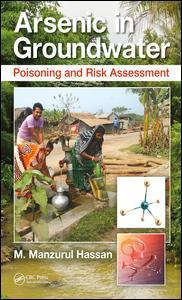Description
Arsenic in Groundwater
Poisoning and Risk Assessment
Author: Hassan M. Manzurul
Language: English
Subject for Arsenic in Groundwater:
Keywords
Arsenic Concentrations; Arsenic; Groundwater Arsenic; Groundwater Contamination; Arsenic Poisoning; Environmental Science; Arsenic Safe Water; Environmental Risk Assessment; Arsenicosis Patients; Arsenic Mitigation; Deep Tubewell; Inorganic Arsenic; Arsenic Exposure; Groundwater Arsenic Contamination; Arsenic Contamination; Groundwater Arsenic Concentrations; BFD Endemic Area; Arsenic Contaminated Drinking Water; T2 Dm; Cumulative Arsenic Exposure; Tubewell Water; Arsenic Toxicity; Chronic Arsenic; Injection Hydride Generation Atomic Absorption; Spatial Risk Assessment; Chronic Arsenic Poisoning; Arsenical Skin Lesions; Urinary Arsenic; Chronic Arsenic Exposure
Approximative price 160.25 €
In Print (Delivery period: 15 days).
Add to cart304 p. · 17.8x25.4 cm · Hardback
Description
/li>Contents
/li>Readership
/li>Biography
/li>
Arsenic-contaminated groundwater is considered one of the world?s largest environmental health crises, as more than 300 million people in more than one-third of countries worldwide are at risk of groundwater arsenic poisoning. This book addresses how arsenic in groundwater impacts human health by using the frameworks of natural sciences, social sciences, and health sciences in the context set by environmental and legal considerations.
Arsenic in Groundwater: Poisoning and Risk Assessment examines the spatial, quantitative, and qualitative aspects on arsenic poisoning; for instance, using geographical information systems (GIS) to investigate the spatial discontinuity of arsenic-laced water in spatial and temporal dimensions to uncover patterns of variations over scales from meters to kilometers. Spatial risk mapping provides insight for academics, researchers, policy makers, and politicians on possible long-term strategies for arsenic mitigation. Qualitative methodological approaches uncover the hidden issues of arsenic poisoning on human health and the related social implications. The book also examines legal aspects, such as the right to safe drinking water, as well as an in-depth look at how community participation can shape public policy.
Features:
- Describes arsenic poisoning from both the scientific and social science perspectives
- Includes technical insights drawn from GIS-based modeling for spatial arsenic discontinuity and spatial health risks of arsenic poisoning
- Provides a state-of-the-art review of the human health literature and cutting-edge scientific evidence for arsenic-related health and social implications
- Examines the environmental justice and legal issues of drinking water and its quality
- Presents environmental policy and public mitigation strategies with Public Participation GIS (PPGIS) related to arsenic contamination
- More than 2,000 references serve as valuable resources for various aspects of arsenic poisoning
List of Figures
List of Tables
Preface
Acknowledgment
Author
Chapter 1 Arsenic Poisoning through Ages: Victims of Venom
Chapter 2 Groundwater Arsenic Catastrophe: The Global Scenario
Chapter 3 Groundwater Arsenic Discontinuity: Spatial Mapping, Spatial Planning and Public Participation
Chapter 4 Chronic Arsenic Exposure to Drinking Water: An Environmental Health Concern
Chapter 5 Risk from Groundwater Arsenic Exposure: Epidemiological and Spatial Assessment
Chapter 6 Arsenic-Induced Health and Social Hazard and Survival Strategies: Experiences from Arsenicosis Patients
Chapter 7 Policy Response and Arsenic Mitigation in Bangladesh
Chapter 8 Arsenic Poisoning in Bangladesh and Legal Issues of Responsibility
Chapter 9 Epilogue and Way Forward
Bibliography
Index
Dr. Manzurul Hassan is Professor of Geography and Environment, Jahangirnagar University, Dhaka, Bangladesh. He is also part-time faculty in the Department of Public Health, and in the Department of Environmental Science and Management, North South University, Dhaka, Bangladesh. His research interests include the groundwater arsenic poisoning, medical waste management, climate change and human health, water supply and sanitation, and Geographical Information Systems. He has written a significant number of papers/chapters in peer-reviewed journals and books. He has a wide range of consulting experience in the above fields as well as monitoring and evaluation, air quality monitoring, and environmental assessment with many national and international organisations.




